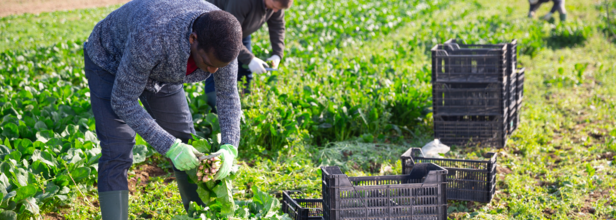- Health Conditions A-Z
- Health & Wellness
- Nutrition
- Fitness
- Health News
- Ayurveda
- Videos
- Medicine A-Z
- Parenting
- Web Stories
Plastics Are Making Its Way Into The Farmlands, Even Organic Is Not Safe

Credits: Canva
In Uganda's Mable district, which is known for its high-quality Arabica coffee, there is a new problem that is taking a shape. It is plastic waste. In colloquial terms, it is referred to as buveera. These plastic bags have long been a familiar sight in Kampala. It has clogged waterways and has even accumulated in layers beneath roads. However, these bags are now reaching remote farmlands, and also affecting agricultural land and coffee production.
Farmers are having a hard time due to the over presence of thick plastic bags which are used in coffee nurseries. Wilson Watira, who is the head of a cultural board for the coffee-growing Bamasaba people, noted that some farmers have also voiced their concerns over the long-term damage these plastics can do to soil.
How Does Plastic End Up In Agricultural Fields?
The issue of plastic waste in agriculture is not just limited to Uganda, but around the world. Climate change too have made agricultural plastics like mulch films, plastic coated seeds, and pesticide containers more common. . However, research shows that plastics, especially microplastics, are affecting ecosystems and human health.
A 2021 report by the United Nations Food and Agriculture Organization (FAO) highlighted that soils are one of the largest recipients of plastic waste. Some studies suggest that agricultural soils contain more microplastics than the ocean. These tiny particles, defined by the National Oceanic and Atmospheric Administration (NOAA) as smaller than five millimeters, can enter food chains when absorbed by plants or consumed by animals and humans.
READ MORE ON MICROPLASTICS HERE
Scientists Are Worried About Microplastics In Soil
Microplastics are so tiny that they can easily infiltrate agricultural land. They could make their way to fertilizer. The wastewater treatment produces biosolids that can contain microplastic particles that later enter farmland as fertilizer. It can also come from seed coatings as some seeds are encased in polymer films which are designed to dissolve after specific times. Then, it can also come from pesticide containers and mulch films, which can degrade over time and shed particles into the soil.
What Are The Health Concerns?
While the agriculture industry accounts for only about 3% of global plastic use, the impact of plastic waste on soil and food production is significant. Scientists are investigating how microplastics affect human health, with early findings suggesting potential links to conditions such as heart disease and cancer. However, many knowledge gaps remain, requiring further research.
Climate Change is Worsening the Plastic Crisis
The global use of plastic has quadrupled over the past 30 years, yet only 10% of plastics are recycled. The rest ends up in landfills, polluting natural environments, or being burned.
At the same time, climate change has increased farmers' dependence on plastic-based solutions. Tarps, greenhouse covers, and synthetic fertilizers help stabilize crops against extreme weather, but they also contribute to plastic pollution.
According to experts, extreme weather events, such as heavy rains and high temperatures, accelerate the breakdown of agricultural plastics. This leads to the spread of plastic particles into surrounding soil and water systems, further contaminating ecosystems.
The Challenge of Reducing Agricultural Plastics
In an attempt to curb plastic pollution, global leaders recently met in South Korea to negotiate the first legally binding treaty on plastic waste. However, no agreement was reached, and discussions will resume in August. Meanwhile, the FAO has introduced a voluntary code of conduct for managing agricultural plastics, though it lacks legal enforcement.
Many companies are working on solutions, such as creating recyclable or biodegradable plastic products. For instance, packaging manufacturer Greif has designed reusable agricultural containers, offering farmers incentives to return them instead of discarding them. However, tracking plastic waste remains a challenge.
Searching for Alternatives
Innovators are exploring ways to filter out microplastics before they spread further. For example, researcher Boluwatife Olubusoye from the University of Mississippi is studying the potential of biochar, a material made from burnt organic waste, to capture microplastics from farm runoff.
In Uganda, small-scale farmers face an uphill battle against plastic waste. Many lack access to sustainable alternatives, such as durable seedling trays, forcing them to rely on cheap plastic bags for germination. Innocent Piloya, a coffee farmer and agroecology entrepreneur, describes the struggle as “little farmers fighting plastic manufacturers.”
Think You Have Flu or Covid? Your ‘Winter Cold’ Could Be Hiding THIS Serious Condition

Credits: Canva
Sniffles and other symptoms often mistaken for a winter virus such as Covid or flu could actually be caused by something else, according to a pharmacist. George Sandhu, deputy superintendent at Well Pharmacy, explained that pollen allergies are now extending into autumn as seasons stretch longer.
He said: “Warmer temperatures are lengthening growing seasons, so pollen counts are higher than in past decades. Rising carbon dioxide levels don’t just warm the planet, they also act like a fertiliser for plants, increasing pollen production.”
What Is a Pollen Allergy?
A pollen allergy happens when your immune system reacts to pollen, which is a fine powder released by trees, grasses, and weeds during reproduction. In people with this allergy, the immune system mistakes pollen for a harmful substance and releases chemicals such as histamine.
This can trigger symptoms like sneezing, runny or blocked nose, itchy or watery eyes, and throat irritation. This condition is commonly called hay fever and tends to appear during certain times of the year when specific plants are blooming, according to the Cleveland Clinic.
Sandhu added that milder winters are allowing some plants to start producing pollen earlier in spring and continue later into autumn. He noted: “Late summer also sees a shift from weed pollen to increased indoor mould, leaf mould, and dust mites, which all peak during autumn. Combined with damp autumn conditions, people with allergies now face a much longer ‘high-risk window’ every year.”
Types of Pollen Allergens
The pharmacist explained the three main types of allergens:
- Weed pollen: including ragweed, mugwort, plantain, nettle, dock, goosefoot, and sorrel.
- Mould spores: thrive in damp autumn conditions and can be found in rotting leaves, compost heaps, soil, as well as bathrooms, kitchens, and other damp areas.
- House dust mites: found in bedding, carpets, soft toys, and fabrics.
Best Treatment for a Pollen Allergy
The best way to manage pollen allergies depends on how severe they are and what suits your body. What helps one person may not work for another. A healthcare provider can recommend the most effective treatment. According to Sandhu, “Antihistamines can relieve sneezing, runny nose, and itching, for example, cetirizine or loratadine. Nasal corticosteroid sprays, such as fluticasone or mometasone, reduce inflammation and congestion. Decongestants may give short-term relief for a blocked nose, but they shouldn’t be used long-term. Saline sprays or rinses can help clear allergens from the nose, and eye drops can soothe itchy, watery eyes.”
Can Allergy Shots Work Against Pollen Allergy?
Allergy shots gradually retrain your immune system to tolerate pollen. They involve a series of injections containing pollen, with the dose slowly increased over time. This helps your body build tolerance. Allergy shots are administered by a healthcare provider.
While it is impossible to avoid pollen completely, you can change some daily habits to reduce exposure. For instance, try not to be outside on warm, windy spring days when pollen levels are high. Pollen counts are usually highest in the early morning and early afternoon.
8 Everyday Habits That Could Be Making Your Bones Weak, Experts Warn

Credits: Canva
You might assume weak bones are a concern only for older adults, but bone strength starts to decline much earlier than most people realise. Often, the first sign that something is wrong comes after a simple fall results in a fracture. Every year, around 50,000 such incidents occur in the UK, and for many, the real shock comes later, when they are told they have osteoporosis, the bone-thinning condition that weakens the skeleton.
An estimated 3.5 million people live with it, while another million have osteopenia, a mild form of bone loss that increases the likelihood of painful and sometimes life-changing fractures.
What Is Osteoporosis?
Osteoporosis is a condition that causes bones to become weak and brittle. It reduces bone density, making them thinner and more fragile. People with this condition are much more prone to fractures, even from minor falls or bumps.
Healthy bones are normally dense and strong enough to bear weight and cushion impact. But as we age, they naturally lose some of their strength and ability to rebuild themselves. When osteoporosis sets in, this process speeds up, leaving bones weaker and far more likely to break. Most people are unaware they have it until a fracture reveals the damage already done.
Daily Habits That Might Be Weakening Your Bones
Hormone specialist Dr Nicky Keay, Honorary Clinical Lecturer at University College London and author of “Myths of Menopause,” explains, “Your skeleton gives your body structure and stability, protects vital organs, and works with muscles to enable movement.” Bones also store essential minerals such as calcium, phosphorus, and magnesium, and the marrow inside certain long bones produces red and white blood cells.
Below are some everyday habits that could be slowly draining your bone strength, and how to counter them.
Dieting: Repeated cycles of losing and regaining weight can harm your bone density,” says dietitian Lorna Cooke from the Sports Institute of Northern Ireland. “Restrictive eating can disturb hormone balance and deprive your body of calcium and other nutrients vital for bone health. When dietary calcium is lacking, the body draws it from bones, which weakens them over time.”
What to do: “Losing weight gradually is safer for bones,” says Lorna. She further suggests sticking to regular, balanced meals so that your body stays nourished. This approach helps you keep the weight off in the long run without harming bone health.
Lack of Vitamin D: “One of the main causes of osteoporosis is vitamin D deficiency,” says Dr Eamon Laird, vitamin D researcher at Trinity College Dublin. “This ‘sunshine vitamin’ is produced when sunlight hits the skin, but during winter, we can’t make enough of it in northern climates.” Because diet alone doesn’t supply sufficient vitamin D, supplementation is often necessary.
What to do: Nutritionist Rob Hobson from Healthspan advises, “Adults should take at least 10 µg of vitamin D daily during winter, and year-round if they’re over 65, spend little time outdoors, or have other risk factors.”
Menopause Matters: Falling oestrogen levels after menopause accelerate bone loss, particularly the hormone oestradiol, which normally helps slow the breakdown of bone tissue. Women can lose around 0.5% of bone density each year after menopause, and by their mid-40s, many already have significant bone reduction.
What to do: Consultant Gynaecologist Tania Adib from The Medical Chambers Kensington recommends, “Women around 45 should have a DXA scan to assess bone density. Building bone strength early and maintaining it through menopause is crucial. Focus on weight-bearing exercise, proper sleep, and a balanced diet.” In some cases, HRT can help prevent bone loss, especially in women experiencing early menopause or severe symptoms.
Ultra-Processed Foods: Strong bones depend on diets rich in calcium and vitamin D, said Rob Hobson. “A diet full of ultra-processed foods lacks the essential nutrients needed for bone strength. These foods often provide excess calories but very few vitamins and minerals.”
What to do: Cut back on ultra-processed foods and cook more from fresh ingredients. A balanced diet that includes wholegrains, lean proteins, fruits, vegetables, and healthy fats ensures your bones get the nourishment they need at every stage of life.
Long-Term Medicines or Illness: Certain conditions, like an overactive thyroid, can increase the rate at which bones lose density. A guide by Viridian Nutrition and GP Dr Siobhan Brennan, notes that some weight-loss drugs, steroids, cancer treatments, antidepressants, and proton-pump inhibitors can also affect bone strength.
What to do: Speak with your doctor or pharmacist about reviewing your medication.
Ditching Dairy Products: Dairy products like milk, yogurt, and cheese are excellent sources of calcium, said Lorna. She further told us, “Cutting them out, whether due to veganism or dietary restrictions, can reduce calcium and vitamin D levels, raising the risk of osteoporosis.”
What to do: Adults need about 1,000 mg of calcium daily. “If you don’t consume dairy, replace it with fortified foods such as plant-based milks or breads, calcium-rich greens, tofu, nuts, seeds, dried fruit, and pulses,” says Lorna.
Gut Diseases: Conditions like Crohn’s disease or colitis can damage the intestine, impairing the absorption of key nutrients such as calcium and vitamin D,” Lorna explains. If untreated, this can eventually lead to osteoporosis.
What to do: Early diagnosis and, if necessary, a specialist diet guided by a dietitian can help the gut heal and absorb nutrients again. Calcium and vitamin D supplements may be prescribed, and a bone scan at diagnosis is a good preventive step.
Too Much or Too Little Exercise: Exercise plays a crucial role in maintaining bone health, but both inactivity and overtraining can cause harm. “Most people do too little, which increases their risk of brittle bones—even in their 30s or 40s,” says Dr Laird.
What to do: Aim for at least 30 minutes of physical activity daily, advises Dr Laird. Include weight-bearing exercises, like walking or jogging, which help keep bones strong and resilient.
3 Period Facts Every Teen Girl Should Know, According To Gynecologist

(Credit-Canva)
Periods or menstruation is a process where the uterus sheds its uterine lining made of mucus, blood, and other components. While most women and girls go through this, there are many misconceptions and myths about it. Many people feel uncomfortable talking about menstruation, which then discourages young girls from coming forth with their problems, and normalizing harmful period symptoms.
Dr. Holly Miller, an OB-GYN, aims to correct the common misconception of what a "normal" period truly entails. In a recent video on Instagram, she detailed how far too many young women suffer in silence because doctors, media, or even peers have dismissed their painful and debilitating symptoms as "just cramps" or "just PMS."
There are many myths about menstruation, UNICEF lists a few with include myths like ‘foods like curd, tamarind and pickles disturb the menstrual flow’. In reality, diet does not determine how your period flows.
The problem of tackling these deep-seated cultural beliefs is made even harder because many girls have very little accurate information about puberty, periods, and reproductive health.
Many of these symptoms can be so difficult to deal with, and early intervention goes a long way. However, how can one know what is normal and what isn’t?
What ‘Normal’ Period Facts Are Actually Red Flags
According to Dr. Miller, these three period experiences are often labeled as normal but are actually red flags that warrant a medical evaluation:
Severe Cramps That Cause Absence from School or Work
Dr. Miller emphasizes that cramps so severe that they necessitate canceling plans, missing school, or leaving work are not normal. If over-the-counter pain medications, such as ibuprofen, are ineffective at managing the pain, it should not be dismissed as simply "bad luck." This level of pain is a significant warning sign for underlying conditions like Endometriosis or fibroids. Dr. Miller encourages patients not to minimize their pain and to clearly tell their doctor if the pain is rated a 9 or 10 on a pain scale, stressing that every patient deserves to be heard.
Bleeding So Heavy It Soaks Through Protection Hourly
Bleeding that soaks through a pad or tampon in less than two hours for several consecutive hours, or passing blood clots the size of a golf ball, is considered excessive and is not normal. This is known as heavy menstrual bleeding, which can lead to serious health issues such as iron deficiency anemia, resulting in extreme fatigue and difficulty concentrating (brain fog). Dr. Miller states that this is a medical condition that requires evaluation to check for potential causes, including clotting disorders, fibroids, or hormonal imbalances.
Debilitating Mood Swings and Extreme Fatigue Before a Period
It's time to stop normalizing severe emotional symptoms and exhaustion as "just PMS." Dr. Miller explains that if anxiety, depression, or mood swings are so extreme in the one to two weeks before a period that they disrupt a person’s relationships or daily life, the individual may be experiencing PMDD (Premenstrual Dysphoric Disorder). This is a severe, yet treatable, form of PMS. Dr. Miller advises that people experiencing these symptoms need professional help to manage the condition, not just a dismissive lecture to "calm down."
© 2024 Bennett, Coleman & Company Limited

